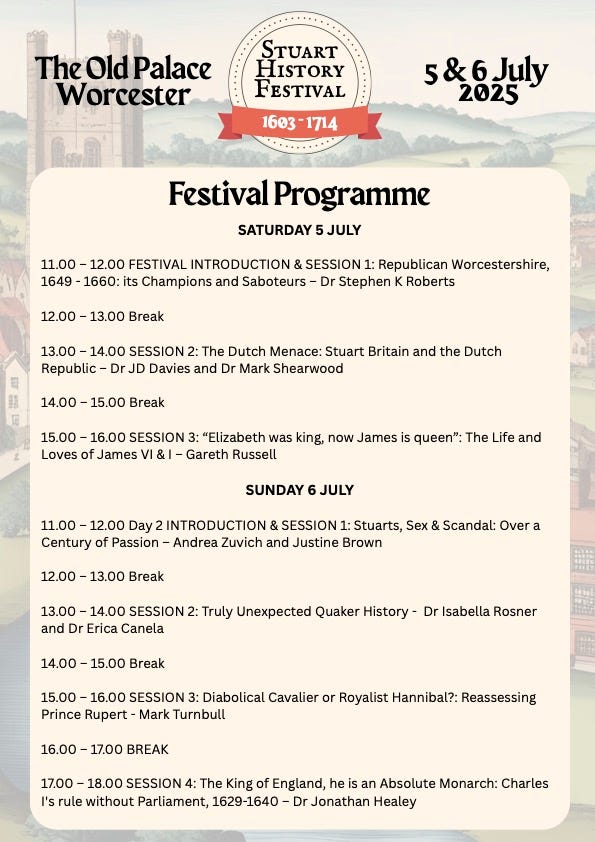Epic sea battles, audacious attacks, humiliating defeats and an invasion!
Let's talk about 'The Dutch Menace!' with Dr Mark Shearwood and Dr JD Davies
Hello fellow history lover!
At 1pm on Saturday 5th July, Dr Mark Shearwood and Dr JD Davies will be on stage at The Old Palace, Worcester discussing the Anglo-Dutch enmity, the ‘Glorious Revolution’, and how these memorable events – and the historical figures involved in them – shaped not only Stuart Britain, but British history itself. The talk is part of the ‘Stuart History Festival’, which I am proud to be supporting. I caught up with Mark and JD before the festival to ask them about “the Dutch Menace.”
J D Davies was educated at Llanelli Grammar School and Jesus College, Oxford, where he completed a doctorate in 17th-century naval history. He won the Samuel Pepys prize in 2009 for his book, 'Pepys's Navy: Ships, Men and Warfare 1649-89', won the Anderson prize in 2017 for 'Kings of the Sea; was shortlisted for the Mountbatten Maritime Literary Award in 2014 for 'Britannia's Dragon: A Naval History of Wales', and is also a previous winner of the Julian Corbett prize for naval history. David is the chairman of the Society for Nautical Research and a Fellow of the Royal Historical Society.
Dr Mark Shearwood is a historian of Identity, Religion, Loyalty and the Glorious Revolution. With a lifelong interest in military history, he completed his master's degree at Leeds in 2018, focusing on the military of the late seventeenth and early eighteenth century from the Monmouth Rebellion to the end of the Great Northern War. His Ph.D. research focused on issues of religion and loyalty within the armies of James II and William III. He is the author of ‘From Pike to Shot: The Perfection of Military Discipline: The Introduction of the Bayonet 1660-1705’ and ‘Waking the Bear: A Guide to Wargaming the Great Northern and Turkish Wars 1700-1721’.


What was the root of Dutch animosity to Britain?
JD: Since the Dutch republic achieved independence in the late sixteenth to early seventeenth century, its merchants and traders had been engaged in bitter and sometimes violent competition with their competitors in the British Isles. Dutch advantages in ship design and trading practices meant that they could usually undercut their rivals across the North Sea, leading successive English regimes from the 1650s to pass a series of Navigation Acts to try to exclude Dutch ships and crews from carrying English goods. These acts increased Dutch animosity towards both republican and then royalist governments across the North Sea. Religion added a further bone of contention. Although both nations were Protestant, Dutch Calvinism was always a more dour and intolerant ideology than that prevailing in England at any given moment.
Mark: I am not sure that animosity is the correct way of viewing the complex relationship between the Dutch and England. The roots of the multiple conflicts from the 1650’s until the 1680’s were complex but distill down to overlapping spheres of influence regarding diplomacy and trade. Both countries were vying for control of trade and trading routes both of known and developing markets within Europe, the Americas, Africa, and the Far East. The Navigation Act of 1651 reduced Dutch influence and trading opportunities that affected the states revenues and was seen by the Dutch as an attempt by England to bar the Dutch from expanding and lucrative markets.
In addition, England’s complex relationship with France and Louis XIV of France was of a deep concern to the States-General of Holland. Holland and France competed for influence and territory within Europe and the Dutch were afraid of a permanent agreement between England and France resulting in English land and naval forces combining with French forces in attacking Holland.
Both Charles I and Charles II tried to normalize diplomatic relations with Holland by arranging royal marriages. Charles I arranged for his eldest daughter, Mary, The Princes Royal to marry William II, Prince of Orange and Stadholder of the United Provinces, while Charles II arranged for the eldest daughter Mary of his brother, James Duke of York to marry their son, William Henry, later William III, Prince of Orange, and also William III of England, Ireland, and Scotland.
Did the Dutch see weakness in the new regime?
JD: Undoubtedly, be it the new republican regime in the 1650s or the restored monarchy after 1660. The chronic instability in the British Isles from 1642 onwards led European nations, including the Dutch, to underestimate or dismiss the frequently short-lived regimes in London, although the stunning victories of Cromwell's army in the 1640s and then his navies in the 1650s did much to restore England's reputation.
Mark: If you are talking about the 1650’s then I cannot answer, but the question is relevant to the late 1680’s and James II.
William of Orange defiantly sensed weakness in James II’s new regime. While he allowed the Duke of Monmouth to launch his failed rebellion in June 1685, he understood that the duke did not have the support to overthrow the new king. William understood that James’s position as a Catholic king in a majority Protestant country was weak with the prevalent anti-Catholic feeling. This basis for the heightened fear of, and loathing towards the English Catholic population during the latter half of 1688 was grounded historic events and ingrained within English social memory, from the common practice of calling England’s last Catholic Queen, Queen Mary, ‘Bloody Mary’ to the memory of the St. Bartholomew's Day massacre in 1572 where French Catholics massacred French Huguenots supposedly on the orders of Queen Catherine de' Medici. Other events that distilled fear amongst the Protestant population included the Spanish Armada of 1588 and the attempted assassination of James I in what is commonly called the ‘Gunpowder plot’ of 1605. More recent events included the Rye House Plot (a plot to Kill Charles II and James, Duke of York in 1683) along with the fabricated ‘Popish’ plots of Titus Oats confirmed these deep-seated fears of the population. The attempts of parliament, although unsuccessful, to bar James II from the English succession and place Princess Mary as next in line to the throne, (The Exclusion Crisis of 1679 to 1681) confirmed to William and his supports both within Holland and England, that James II’s position was weak and he was in a position where he could be overthrown.
Continued Whig and anti-Catholic propaganda, increased the fears that James II intended to copy Louis XIV of France and become an authoritarian monarch with the intent of converting the whole country to Catholicism. Williams further undermined the king by working with senior figures within Parliament, the Lords, Church of England and the military. A number of senior military figures became members of the ‘Treason Club’, based out of a inn in London and helped set the scene for the events of 1688. William used his links to the English succession through his wife, who was next in line to the throne (until James II’s son was born in June 1688) as his stated reason of ensuring a Protestant succession to the English throne.
What did they plan to do with Britain if they had won in the 1650s?
JD: There was never any serious prospect of the Dutch invading and conquering Britain in the 1650s or later. Territorial acquisition in Europe of the kind practised by King Louis XIV was not on the agenda and for most of the period it wasn't on England's either. The exception was in 1672-3, when Charles II was allied to Louis and they both plotted a joint invasion of the Netherlands, the French by land, the English by sea. Charles aimed to place some, if not all, of the province of Zeeland under his rule, and formed an army on Blackheath for the purpose. But the invasion force never got beyond Yarmouth, the French were suspicious, and in any case Dutch resilience and naval success ended the prospect of any invasion taking place.
Mark: My short answer would be that Holland did not have any plans to do anything with Britain as these were not wars of invasion or conquest, but wars based on trade and the overlapping spheres of influence of Britain and Holland. Both sides were looking to gain diplomatic concessions regarding trade and the placement and control of overseas territories.
Were the seeds for the so-called ‘Glorious Revolution’ of 1688 sewn in the 1650s?
JD: Only in the sense that the experience of exile in the 1650s, and especially their time in France and Spain, convinced both Charles II and especially his brother James, Duke of York, of the merits of strong Catholic monarchies. James announced his conversion to Catholicism in the late 1660s, and from then on political discourse in Britain was dominated by the prospect of his eventual succession to the throne and fears of what that might entail. This all came into sharp focus following the death of Charles and the accession of James in 1685. But memories of the previous three decades contributed greatly to the Glorious Revolution, with James and his propagandists attempting to stress that the Dutch preparations and subsequent invasion in 1688 were nothing less than the beginning of a fourth Anglo-Dutch war. But by then, fear of Catholicism and of James's perceived ties to Louis XIV sufficiently outweighed the abiding rivalry with the Dutch to convince large numbers in the British Isles, especially soldiers and sailors, to overthrow their lawful king.
Mark: While this is a good question based on the history of the two countries, the ‘seeds’ for the ‘Glorious Revolution’ of 1688 were not sewn in the 1650’s but in February 1685 when Charles II died and his Catholic brother James II succeeded to the throne of England, Scotland, and Ireland. William’s publicized aims of restoring James and England to the Protestant faith and for allowing free elections of parliament was pure propaganda for the English population. His agreement with Pope Innocent XI and the subsequent Papal Bull stated that his intent was to secure the throne for his Protestant wife and that he had no intention of subjugating the English Catholic population. While these reasons were correct, in reality his primary objective was to secure the use of the English army and navy for use against Louis XIV of France and not for James II to join with France against the States-General. The plans for the ‘Glorious Revolution’ of November 1688 were started in 1687, a whole year prior to the Birth of James II legitimate son and the ‘invitation’ by the ‘immortal seven’ (sent in June 1688).
You can see DR JD Davies and Dr Mark Shearwood at the Stuart History Festival at the Old Palace, Worcester at 1pm on Saturday 5th July. If you wish to attend in person please purchase your tickets in advance. Click here to find out more.
You can find JD on his website - jddavies.com or on social media: Facebook - https://www.facebook.com/jddaviesmaritime | X - @quintonjournals |Bluesky - @jddavies.bluesky.social
You can find Mark on X @shearwood_Mark
The Stuart History Festival Tickets
In Person
Location: The Old Palace, Worcester, Worcestershire
Online
Great news! Wherever you are in the world you can attend the Stuart History Festival. An Online Pass is also available which allows you to watch live, and play back for a limited time, for just £45. Find out more by clicking the button below.
Festival Schedule
Visit https://www.tickettailor.com/events/thestuarthistoryfestival for full details and to purchase all tickets, day passes and the online pass.
Books and Book Signings
Books from the speakers will be available to buy at the festival but if you can’t make it, or are watching online you can buy them online and have them shipped anywhere in the world, at Blackwells, click on the banner below.
My Interview with the Organisers
Find out why the 17th Century is such a great topic for a festival of its own - and why we think it hasn’t already got one, in my interview with the festival’s organisers; Dr Erica Canela, Andrea Zuvich and Mark Turnbull.
Next time…
‘Charles II - Was there more to him than bad-boy party king?’, with Andrea Zuvich and Justine Brown.
See you soon!
Philippa 💜
Books by the Speakers
Dr JD Davies:
Pepys's Navy: Ships, Men and Warfare 1649-89 (Seaforth, 2009)
Kings of the Sea: Charles II, James II and the Royal Navy (Seaforth, 2017)
Dr Mark Shearwood:
Waking the Bear: A Guide to Wargaming the Great Northern War and Turkish Campaigns 1700-1721 (Warwick: Helion & Co 2021) ISBN: 9781913336615.
The Perfection of Military Discipline: The Plug Bayonet and the English Army 1660 – 1705 (Warwick: Helion & Co, 2020) ISBN: 9781913118877.
‘A Summer on Hounslow Heath: Combined Army Operations in late Seventeenth-Century England’ first published online Open Access July 2021 War in History. https://doi.org/10.1177/09683445211029974. Published: Volume 29 Issue 3, July 2022.
‘William of Orange and the Glorious Revolution’, Arquebusier: Journal of the Pike and Shot Society. 35.6 (2017), 26-35.







